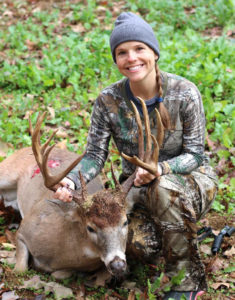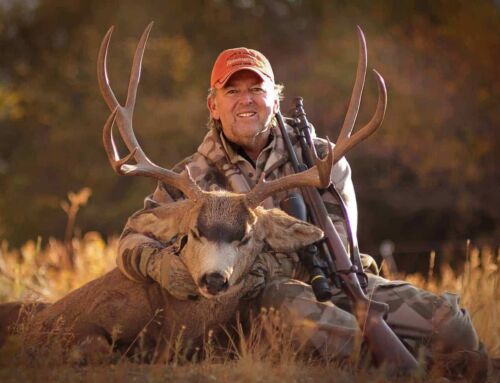 The walls are lined with racks, big ones. Tacked between the sneakers and skull mounts are ink-stained aerial photos and framed prints of the same 40-something guy with the cheesy grin, his hands clamped on the beams of a dozen giant bucks. Topo maps are rolled and stacked in a corner by the gun safe. Shed antlers litter the floor like old bones in a cave. This is my buddy’s war room, the place where he goes to plot his hunts.
The walls are lined with racks, big ones. Tacked between the sneakers and skull mounts are ink-stained aerial photos and framed prints of the same 40-something guy with the cheesy grin, his hands clamped on the beams of a dozen giant bucks. Topo maps are rolled and stacked in a corner by the gun safe. Shed antlers litter the floor like old bones in a cave. This is my buddy’s war room, the place where he goes to plot his hunts.
Walk in, gawk the heads, and you’ll wonder, Iowa, Saskatchewan, Kansas? “Nah, I killed ‘em all right around here,” Rick says. “Most came from the woodlot just down the road.”
Rick’s story is not uncommon among America’s top everyday hunters. They understand that you don’t necessarily have to travel thousands of miles to whack a monster. You don’t have to tap your home-equity line to hire an outfitter. The fact is, most of the woodlands and thickets around Eastern, Midwestern, and Southern cities and towns hold lots of whitetails and some mighty fine 8- and 10-pointers. You’ve just got to find a good spot and then hunt it smartly.
Think Small
Many people still believe you have to hunt 500 to 1,000 acres or more to shoot big deer with regularity, but that is just not the case. Most any farm or woodlot of 50 to 200 acres on the outskirts of suburbia will hold whitetails and some bucks in the 125-inch range minimum. Many properties with quality food sources and cover will have 15 to 40 or more deer per square mile, and an impressive lot of eye-popping bucks.
The smaller the woodland or thicket, the more other people will ignore it as they scrounge around for a larger property to hunt. That’s good for you. I’ve actually come to prefer a small to mid-size tract over a big wood if my buddies and I can lock it up. Anytime you’re on 500 or more acres you’ll generally have to share it with a few or an army of other hunters. Either way, the pressure will impact your methods, limit your stand locations, and reduce your odds of tagging bucks. You’ll get lucky every once in a while, but don’t count on it every season.
But if you can get the exclusive hunting rights to a 100- to 300-tract with top-end habitat and maybe 20 to 30 deer per square mile, you’re in business my friend. It might be a mix of woods and thickets a half-mile behind a new golf course or strip mall…or a remnant corner of a farm carved into building lots… You get the idea—big deer hide in all sorts of nooks and crannies these days. If you and a partner or two can swing the cash to lease a spot like this, do it. That way you can hunt when, where, and how you want to. You’ll fill your buck tags most every year, and you’ll shoot enough does to keep your freezer stacked.
Now is the time to start scanning aerials of your county and adjoining counties. On a paper map, circle spots that intrigue you. On an app, drop pins. Mark potential feed fields depending on a farmer’s crop rotation, oak ridges and creek funnels with heavy cover nearby. Drive out and check the spots from the road. If there’s no house on a piece of good-looking land, visit your county courthouse, check the plats, and find out who owns it. Keep your ears open. Your kid’s bus driver or the UPS guy might tell you about the monster he’s been seeing just down the road and near a woodlot you’ve got your eye on.
Start knocking on doors. Some people won’t let you hunt, and that’s their prerogative. Bid them a fond farewell and move on to the next property on your list. Sooner or later you ought to have luck, especially in a high-population area where deer are hammering a landowner’s crops, azaleas, or fruit trees. Once you get permission, be a good steward of the land. If you love spot and see big deer there, definitely offer a lease fee if you can. Remember, it all comes down to the pressure factor. The less people that roam a land, the better the buck hunting will be. Here’s the whopper bonus: A mother lode of animals will pile into the largely undisturbed covers on your side of the fence when the guns start booming on surrounding lands this fall.
Oddball Public Spots
One November I spent a week on a ranch out near Sheridan, Wyoming. Every day we sat on ridges, glassed the crops and creeks below, and spotted 30 to 50 whitetails. There were plenty of bucks, with racks ranging from 120 to 140 inches. What made the hunting totally cool as I waited for the deer I wanted to shoot was the fact that we were able to glass 20 to 30 muleys, 6 to 10 elk, and huge bands of pronghorns too.
One morning as we drove to our spot I spotted a pickup on the side of the road. “Who’s that?” I asked my guide Herb.
“There’s a small piece of state land in there,” he replied, waving to a small strip of timber across the ditch. “He won’t bother us.”
No, I thought, but he might ruin a big buck’s day. That dude was smart. He had ferreted out a remote and non-descript few hundred acres (I didn’t see a public access sign anywhere) out in the middle of nowhere and surrounded on all sides by private ranches that teemed with game. He hunted on Wednesday, just about guaranteeing he’d have the run of the woods. His odds of tagging a public-land buck were as good as they get.
It might be a small state forest or WMA in a remote corner of a county 40 or 50 miles from your house. Or 20 acres around a ramp where you launch your bass boat in the summer. I recently heard of a guy who bowhunts on a couple of acres adjacent to a municipal landfill. There are plenty of overlooked spots like that across the country, and more coming into the public domain every day. The best way to stay up to date is to visit your state and county websites once a week. Check for new postings on public lands, and investigate any intriguing possibilities. Access varies widely on these types of offbeat tracts, so check your state and local regs carefully.
Company Lands
From Alabama to Michigan to Maine, energy and timber companies own tens of millions of acres. Some of it you can roam for free or a small access fee. Opportunities are available on lands owned by International Paper, Peabody Energy, Mead Westvaco, and others. But it’s not just the giant corporations that will give you access. Some of my best deer and turkey hunting takes place on old strip mines owned by an independent coal operator in southwest Virginia.
Most of the lands have great game habitat because to boost their image, companies are pumping more money into wildlife programs than ever before. On a typical paper-company tract, pines and hardwoods are thinned and cut at various intervals. Planted pines grow dog-hair thick. Whitetails browse in the edges and clear-cuts and bed nearby.
During the last 30 years millions of coal-mined acres have been restored for wildlife habitat across the country. Once a mine is closed, a company grades high walls, fills pits, and plants grass, clover, and trees. They create new areas that attract lots of game. The manager of one coal property I hunt told me that so many whitetails “and some monster bucks” have poured onto the reclaimed ground in the past two years that the company would soon double the number of free archery permits they dole out. That’s the kind opportunity to look for.






